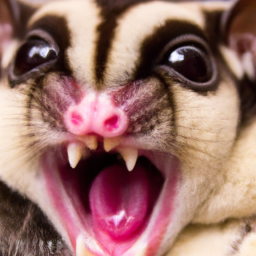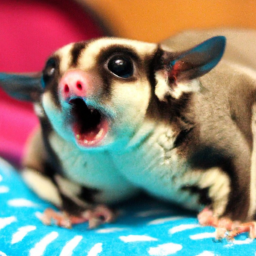Do Sugar Glider Bite
Hey there! Have you ever wondered if sugar gliders bite? Well, let me tell you, it’s a common question that many people ask when considering these adorable little creatures as pets. Sugar gliders are small, nocturnal marsupials native to Australia, and they have become quite popular as pets in recent years. But before you bring one home, it’s important to know whether they have a tendency to bite.
In our upcoming article, we’ll dive into the intriguing world of sugar gliders and explore whether or not they bite. We’ll discuss their natural behavior, their teeth and jaws, and the factors that can influence their propensity to bite. Whether you’re a current sugar glider owner, a prospective owner, or simply curious about these fascinating animals, this article will provide you with all the information you need. So stay tuned and get ready to learn more about whether sugar gliders commonly bite or not.
What are Sugar Gliders?
Sugar gliders are small, nocturnal marsupials native to Australia, Indonesia, and New Guinea. They are known for their unique ability to glide through the air, thanks to a membrane stretching from their wrists to their ankles. These adorable creatures have become popular pets in recent years due to their playful nature and ability to form strong bonds with their owners.
Physical Characteristics
Sugar gliders are approximately 5-6 inches in length, with a tail that adds another 5-6 inches to their overall body length. They weigh between 3 to 5 ounces and have large, round eyes that allow for excellent night vision. Their fur is typically gray or silver, with a black stripe running from their nose to their forehead. This distinctive marking gives them the appearance of wearing a “mask.”
Habitat and Behavior
In the wild, sugar gliders can be found in forests and woodlands, where they reside in groups called colonies. They are social animals, and bonding is an essential part of their behavior. They communicate through a variety of sounds, including chirping, barking, and hissing.
Sugar gliders are also known for their playful nature. They love to climb, leap, and glide from tree to tree in search of food. Their diet consists mainly of nectar, fruit, and tree sap, but they also consume insects and small vertebrates.
Understanding Sugar Glider Behavior
To ensure a harmonious relationship with your sugar glider, it is important to understand their behavior and needs.
Bonding and Socialization
Sugar gliders are highly social animals and form strong bonds with their owners. It is crucial to spend quality time with your glider for them to feel secure and develop trust. Regular handling, gentle petting, and providing opportunities for interaction are essential for bonding.
Nocturnal Nature
As mentioned earlier, sugar gliders are nocturnal creatures. This means they are most active during the night and may be less active or even asleep during the day. It’s important to adjust your schedule to accommodate their natural behavior and provide them with a quiet and dark environment during their daytime rest.
Grooming Habits
Sugar gliders are meticulous groomers and spend a significant amount of time cleaning themselves. They have a specialized tooth comb on their second toe, which they use to groom their fur and keep it clean. Occasionally, they may need assistance in removing dirt or debris from their fur, but overall, they are quite self-sufficient when it comes to grooming.
Reasons Behind Sugar Glider Biting
While sugar gliders are generally friendly and social, they may occasionally bite. It is essential to understand the reasons behind their biting behavior to address it appropriately.
Fear or Anxiety
Like any animal, sugar gliders may bite when they feel threatened or scared. This can happen if they are approached too quickly or if they are in an unfamiliar or stressful environment. It is important to approach your glider calmly and avoid any sudden movements that may trigger fear or anxiety.
Lack of Handling
If a sugar glider is not properly handled or gets limited interaction with humans from a young age, they may develop fear or become aggressive. Regular handling and socialization are critical to prevent these issues and ensure your glider feels comfortable and secure around people.
Protecting Territory
Sugar gliders have a strong instinct to protect their territory. If they perceive a threat or feel the need to defend their belongings, they may resort to biting. Providing them with a dedicated space that they can call their own and respecting their boundaries can help alleviate territorial concerns.
Signs of a Biting Sugar Glider
It’s important to recognize the signs that a sugar glider may bite to prevent potential injuries. Here are some indications to watch out for:
Aggressive Body Language
When a sugar glider is feeling threatened or aggressive, they may display certain body language cues. These may include a hunched or arched back, raised fur, and bared teeth. Recognizing these signs can help you anticipate a potential bite and take appropriate action to prevent it.
Lunging or Biting Gestures
A sugar glider may often lunge or make biting gestures as a warning before actually biting. This is their way of signaling that they are feeling defensive and should not be approached or handled at that time. It is important to respect their boundaries and give them space when they exhibit such behavior.
Vocalizations
Sugar gliders may emit certain vocalizations, such as hissing or growling, when they are feeling aggressive or threatened. These vocal cues are a clear indication that they are not comfortable with the current situation. It is crucial to understand and respect their communication efforts to avoid the risk of being bitten.
Tips for Preventing Sugar Glider Bites
While sugar gliders may occasionally bite, there are steps you can take to minimize the risk. By following these tips, you can create a safe and harmonious environment for you and your glider:
Proper Socialization and Handling
Start socializing your sugar glider from a young age to familiarize them with human interaction. Handle them gently and frequently, allowing them to get used to being touched and held. This will help build trust and reduce the likelihood of biting.
Encouraging Trust and Bonding
Focus on building a strong bond with your sugar glider through positive reinforcement and rewards. Use treats and gentle praise to reward good behavior and create positive associations. This will enhance their trust in you and reduce the likelihood of aggressive behavior.
Providing Appropriate Toys and Enrichment
Sugar gliders are active animals that need mental and physical stimulation. Give them a variety of toys, climbing structures, and safe hiding spots to keep them engaged. Providing adequate mental and physical stimulation can help reduce their stress levels and minimize the risk of aggression.
What to Do If You Get Bitten
Despite taking precautions, there may still be instances where you get bitten by your sugar glider. Here’s what you should do in such situations:
Remaining Calm
If you get bitten, it’s essential to remain calm. Sudden movements or panic may only escalate the situation. Try to gently remove your hand or any body part that has been bitten and give your glider space to calm down.
Washing the Wound
Once you have safely removed yourself from the glider’s reach, clean the wound thoroughly with mild soap and warm water. Apply an antiseptic ointment and cover the wound with a bandage if necessary. Keep an eye on the wound for signs of infection and seek medical attention if needed.
Seeking Medical Attention if Necessary
In case of deep or severe bites, as well as signs of infection, it is crucial to seek medical attention from a healthcare professional. They can assess the extent of the injury and provide appropriate treatment.
Training and Taming Sugar Gliders
With patience and consistency, it is possible to train and tame sugar gliders to minimize biting and aggressive behavior. Here are some tips to help you during the training process:
Establishing Boundaries
Set clear boundaries for your sugar glider’s behavior from the beginning. Establish rules about handling, climbing on furniture, and interacting with other pets or people. Consistently enforce these boundaries to avoid confusion and foster positive behavior.
Positive Reinforcement
Use positive reinforcement techniques, such as offering treats or verbal praise, to reward desired behaviors. This can include coming to you when called, not biting during handling, or using their designated toilet area. Positive reinforcement helps to reinforce good behavior and strengthen the bond between you and your glider.
Patience and Consistency
Taming sugar gliders can take time and patience. They need to feel secure and trust their owners before they can be successfully trained. Be consistent with your training methods and spend quality time every day with your glider, gradually increasing the duration of these interactions. Eventually, you will see progress and a reduction in biting behavior.
Myths and Misconceptions about Sugar Glider Bites
There are some myths and misconceptions surrounding sugar glider bites that need to be addressed.
All Sugar Gliders Bite
While it is true that sugar gliders may bite on occasion, not all gliders are aggressive or prone to biting. With proper socialization, handling, and training, their biting tendencies can be significantly reduced.
Biting is Always Aggressive
Biting from sugar gliders is not always indicative of aggression. It may be a result of fear, anxiety, or territorial instincts. By understanding their behavior and addressing the underlying causes, you can effectively reduce and prevent biting incidents.
Legal Considerations for Owning Sugar Gliders
Before getting a sugar glider as a pet, it is essential to be aware of the legal requirements in your area. Some jurisdictions may have specific regulations regarding the ownership of sugar gliders. Research local laws, including license and permit requirements, to ensure compliance with the law and the well-being of your pet.
Can A Sugar Glider’s Diet Affect Its Aggression and Likelihood of Biting?
A proper sugar glider diet essentials can influence its behavior and prevent aggression. A well-balanced diet rich in fruits, vegetables, and protein reduces stress and increases overall health, reducing the likelihood of biting. Providing the right nutrition is key in maintaining a calm and friendly sugar glider.
Are Sugar Gliders Aggressive Due to Their Evolutionary Background?
The behavior of sugar gliders can be attributed to their sugar glider evolution origins. They are not naturally aggressive, but their instincts from their evolutionary background may cause them to be protective or defensive. Understanding their evolutionary traits can help in creating a suitable environment for them in captivity.
Conclusion
In conclusion, sugar gliders have the potential to become wonderful and affectionate pets. While they may occasionally bite, understanding their behavior and needs can help prevent and address biting incidents effectively. By following proper socialization techniques, establishing boundaries, and providing a stimulating environment, you can foster a strong bond with your sugar glider while minimizing the risk of biting. Remember, patience, consistency, and a friendly approach are key in creating a harmonious relationship with your glider.



